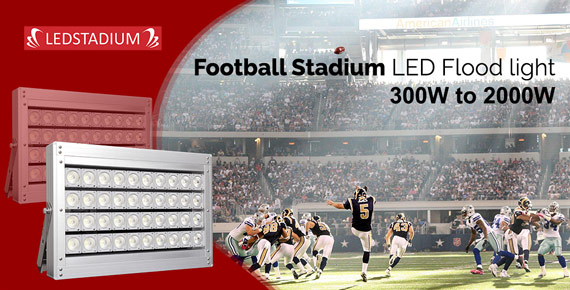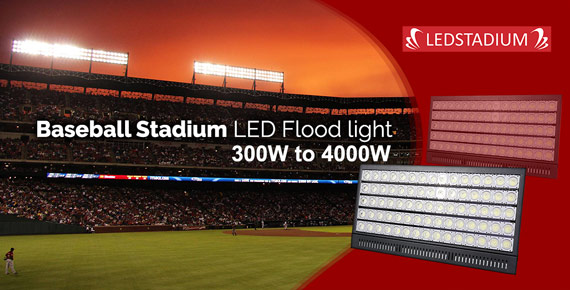We are sharing with you the ultimate guide on selecting the best sports lighting. As a lighting company, we supplied top-tier LED lighting fixtures for outdoor or indoor sports field like football, basketball, tennis, golf and more. You can acquire more knowledge about the lighting design, as well as the benefits of replacing the metal halide or other HID lights source with LED. Enjoy reading!
What is Stadium Lighting?
Sports is considered to be any physical activity that demands a particular set of skills and teams to participate and compete against each other for the sole reason of entertainment. For these sports to take place there need to be dedicated venues which are called stadiums that should accommodate the participants and the fans. They can take place during any time of the day and lighting plays an important part in making sports success. Stadium lighting is, therefore, the incorporation of artificial lighting in the stadiums to help mimic the natural lighting during the day to ensure the continuity of the sports.
Due to the advancement of technology, there has been a massive improvement in the lighting of the stadiums where it becomes difficult to distinguish between day and night. Bright LED lights are now been used in many stadiums which is proving vital and necessary in the sporting world.
Latest Articles
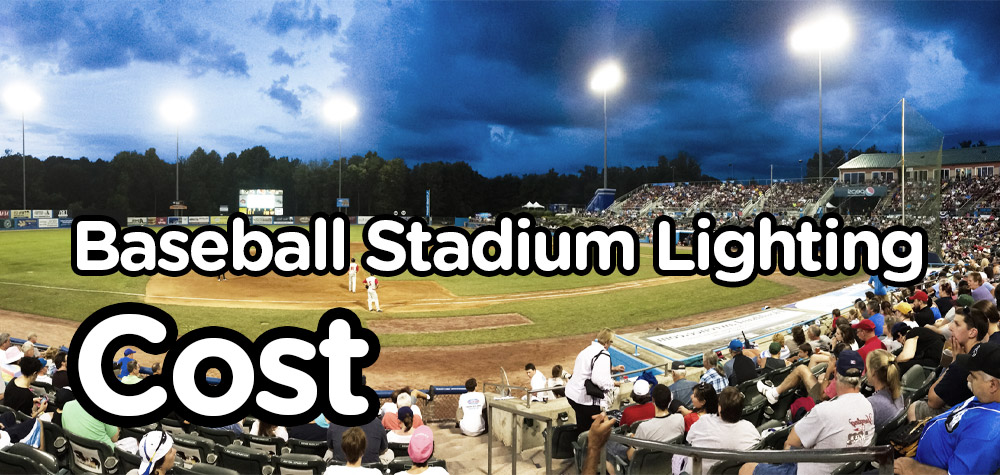
Softball and Baseball Field Lighting Cost
Baseball field lighting is important for players and fans. Games can be held either day
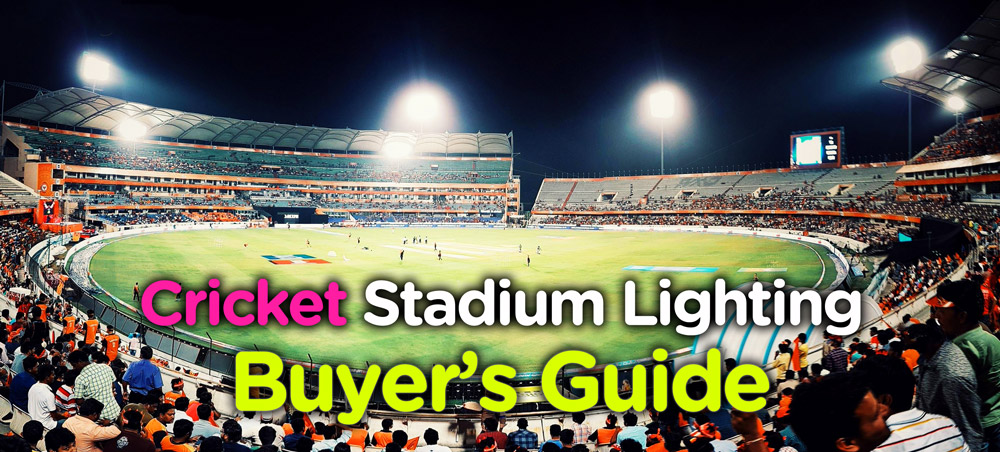
Cricket Stadium Lighting Buyer’s Guide
Cricket stadium lighting involves more than the installation of flood lamps on high points. Before
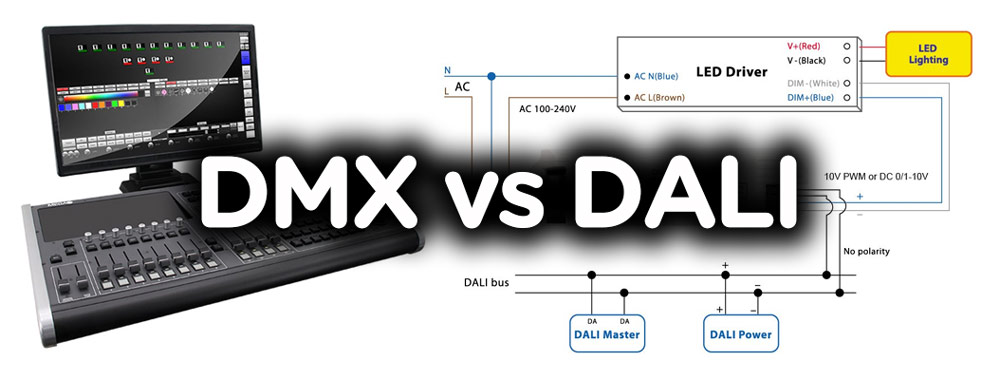
DMX vs DALI Lighting Control [High Mast Light Pole]
With the advent of technology smart lighting control systems have enabled energy conservation and increased
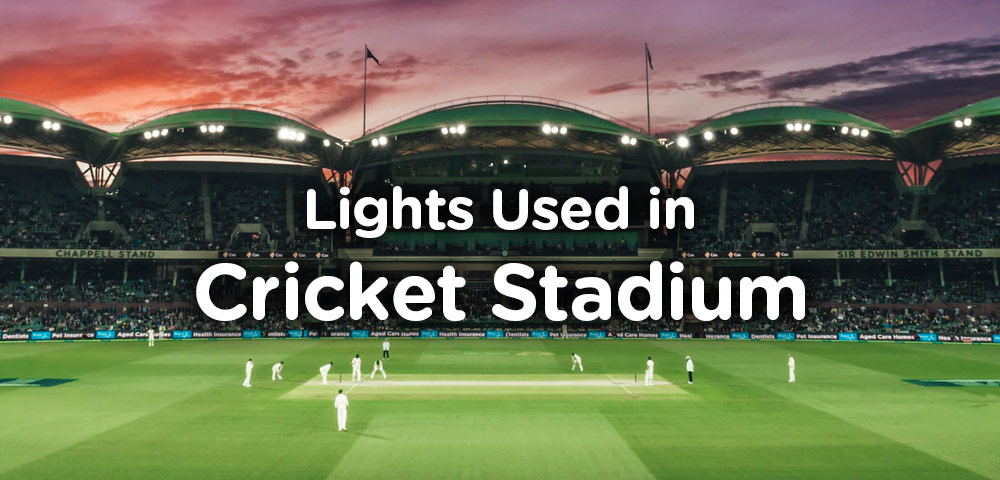
What Lights are Used in Cricket Field & Stadium?
When we are finding the suitable cricket field lighting system, the first and foremost questions
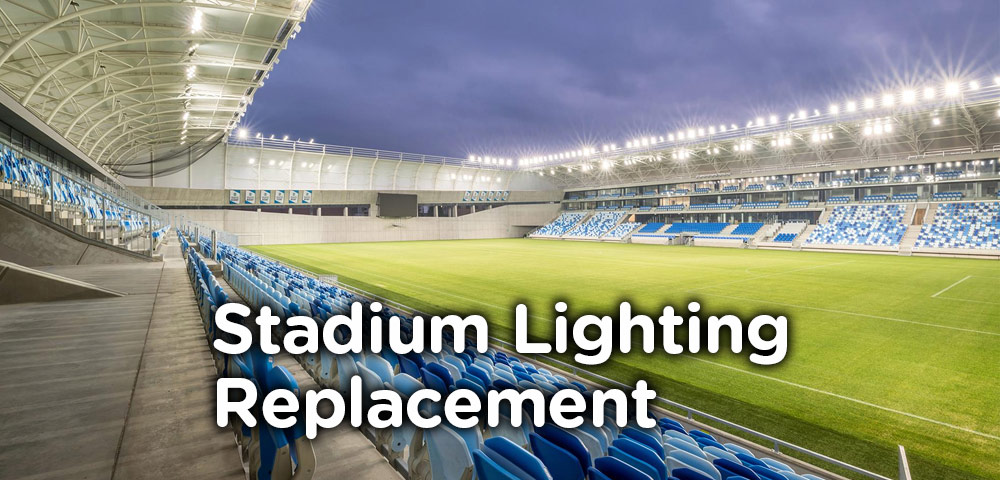
How to LED Replace Metal Halide or Halogen Stadium Lights (1000W to 2000W)
Are you planning to replace 1000W, 2000W or even higher wattage metal halide or halogen

12 Tips on How to Choose the Best Stadium Lighting Manufacturer
Stadium lighting involves more than just the installation of lamps at strategic points. It comes
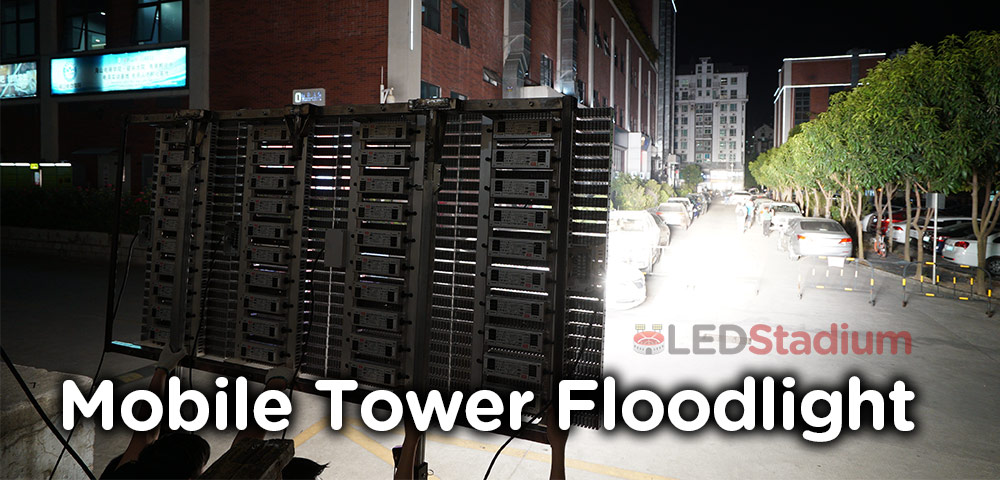
What is Mobile Sports Floodlights? How this Portable Field Lights can be Used?
Mobile tower lighting can be described as a portable lighting system designed to illuminate spaces
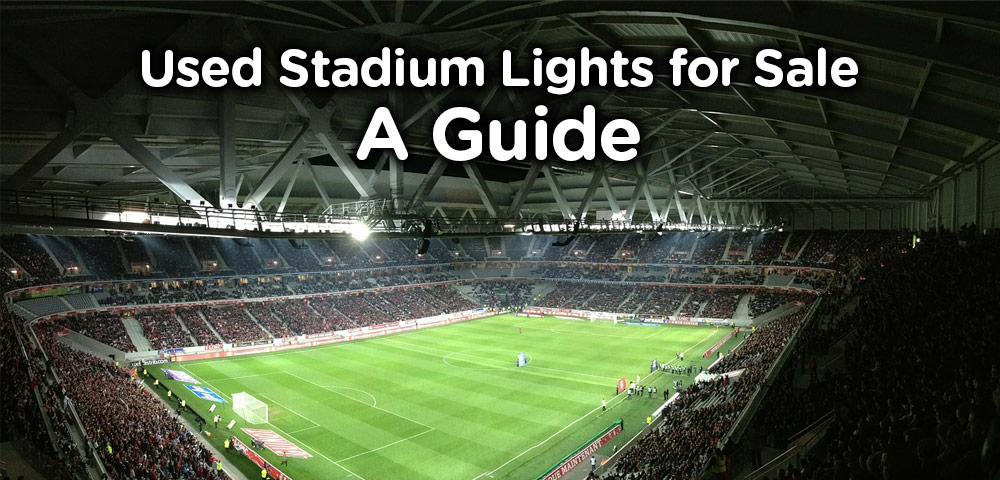
Used Stadium Lights – Pros & Cons of Buying Sale Football Field Lighting
We’ve all seen them. The bright lights beaming down onto the field of play. Stadium

3000K vs 5000K vs 6000K Sports Lighting: Which is Best for Footballer?
In the last few years LED lights have gained a lot of popularity because these
Contact Us for Quote & Free Lighting Advice
Types of Sports Field Lighting
1. Football Field & Stadium Lights
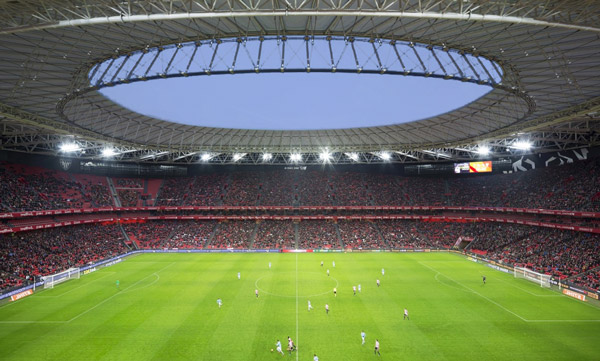 Installing lighting in a football field or a stadium can provide a number of benefits to the fans, players, and administration. Some of the benefits of having football fields and stadium lights include flexibility planning of matches, security of people in the stadium, and enhancement of the fans’ experience. Based on your needs, you can decide to have temporary or permanent stadium lights.
Installing lighting in a football field or a stadium can provide a number of benefits to the fans, players, and administration. Some of the benefits of having football fields and stadium lights include flexibility planning of matches, security of people in the stadium, and enhancement of the fans’ experience. Based on your needs, you can decide to have temporary or permanent stadium lights.
Temporary lights are self-contained units. They are portable and mostly used for specific games or events. Permanent lights are fixed on poles for long-term solutions. Based on your budget and your needs, you can choose between the two options.
5 Tips for buying football field or stadium lights
Lighting football fields and stadiums is an experience that continues to get better with time. When the lights are installed, players have some lights directed to them. This helps them to play well and the spectators can be able to see clearly. Choosing football field and stadium lights might be a challenge to many people. If you are planning to install the lights in your football field or stadium, here are some tips that will ensure you pick the best.
a. Check the beam angle
Beam angle commands how the light is dispersed in the field. If the angle is narrow, the light uniformity is low. But if the angle is wide, the light regularity is high. Therefore, the lights you pick must have proper beam angles to create a balance in the stadium.
b. Go for quality lights
Always go for high-quality lights that can provide enough brightness and cool temperature to the football field. Although there are several top brands to choose from, you need to ensure you pick the best. Happily, the malfunction rate of field and stadium lights is low. But make sure you go for the high-quality ones.
c. Choose waterproof lights
The effectiveness and longevity of football field lights depend on a number of factors. One factor is being waterproof. Since the lights can be affected by conditions such as humidity and water, you cannot neglect the factor. Therefore, check the ratings to ensure they can perform well under the harsh weather.
d. Consider heat dissipation
The stadium lights can easily get damaged due to overheating. A good system should have proper ventilation. So, when choosing the lights, consider ones that are made of pure aluminum. This is because more advanced aluminum has the highest conductivity rate.
e. Glare ratings
Even though most people do not consider the glare rate when choosing the football field and stadium lights, it is an essential factor when it comes to sports lighting. This is because when the glare is too much, it can cause visual discomfort to footballers and the fans.
Football fields and stadiums have benefited a lot from the lighting system. They have improved the security of the fans and footballers. Moreover, the neighbors and the business around the stadiums have benefited. But when planning to install the lights, ensure you follow the rules and consult the neighboring community to ensure the light does not drop to their home.

2. Tennis Court Lights
When you are looking to install a tennis court on your property, or as part of an upgrade on rental or commercial properties, an integral part of the court will obviously be the equipment including rackets, balls, and of course the net. The court itself, whether an artificial turf, clay, or real grass, will likely have some fencing or other types of the surrounding enclosure to keep errant balls from being hit outside and damaging passing cars or buildings, or other property. As important as all these considerations are, what if you are a busy person who works all day, and only has time to play on your court in the evenings? You will want to consider lighting for your court, of course.
a. How to achieve better lighting for tennis court
When considering illuminating your tennis court, the proper lighting decisions can often seem intimidating to make. You may not know the structural supports, wattage, or even type of light bulb you will need. You will be walking into this in the dark, so to speak. The good thing is, you will be able to talk to an expert who installs tennis court lighting professionally. Online, you will likely find companies who do this close to your location, or at least within reasonable driving distance. You can either go to their offices or warehouses or have a knowledgeable expert come to you. In either case, they will have the right equipment and expertise to fit your needs, setting you up with the correct array of lights, their supports, and sufficient wattage to make your court bright enough for you to play those evening or late-night games.
b. Cost & installation
Once you know what sort of lighting packages are offered, those within your price range can be considered, and you can choose one to your liking. You can look for the aesthetics of each package that suits your taste and your court’s plan. Then, you can choose to install it yourself, having the hardware and fixtures delivered to your property. A better way to go, unless you have a lot of experience in electrical work, is to have a professional install the lighting in your tennis court. This way you are guaranteed a professional installation, and we will offer a warranty on their work if anything goes wrong within a set period of time. The peace of mind that comes with having a professional tennis court lighting specialist install the fixtures, supports, and of course the light bulbs will ensure you have the correct placements and wattage to make your games at night illuminated enough to see the ball!
The great exercise and benefits that come from having a tennis court on your property are lessened if you can’t play after work when it gets dark. You may find that when you are faced with choosing the lighting for this task, it is more than you think you can handle. Rest assured, by consulting with experts in the field you will be able to find the exact equipment you need so that you can play well into the evenings.
3. Cricket Field Lights
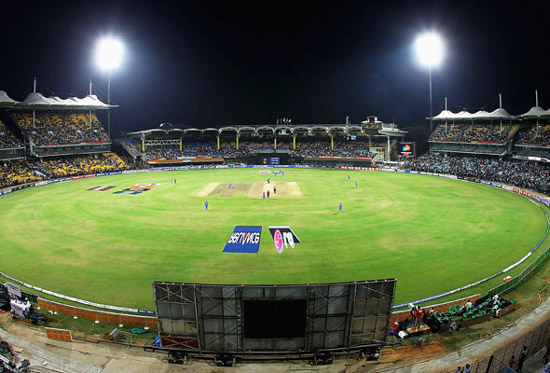 Good and proper lighting is essential to the success of any sporting event. Irrespective of whether the sport is played outdoor or indoor, as a leisure activity or as a professional championship, in daylight or at night, the importance of proper lighting remains the same and can never be downplayed. And with the increasing demands of HD broadcasting, increasing audience and the need to play at night, the demands of proper lighting at cricket fields or venues have never been this high. So, what are some of the most important things to consider when lighting a cricket field?
Good and proper lighting is essential to the success of any sporting event. Irrespective of whether the sport is played outdoor or indoor, as a leisure activity or as a professional championship, in daylight or at night, the importance of proper lighting remains the same and can never be downplayed. And with the increasing demands of HD broadcasting, increasing audience and the need to play at night, the demands of proper lighting at cricket fields or venues have never been this high. So, what are some of the most important things to consider when lighting a cricket field?
a. Getting an evenly Spread Illumination
Getting a consistent level of evenly spread lighting across the playing field is very fundamental. In cricket, the objects of observation such as the ball and the puck move very fast in random directions and their angular sizes may vary greatly. For players, referees and of course, players to watch these movements as deserved, it’d only be possible if the field’s illumination is evenly spread across the entire playing field.
b. Level of Brightness
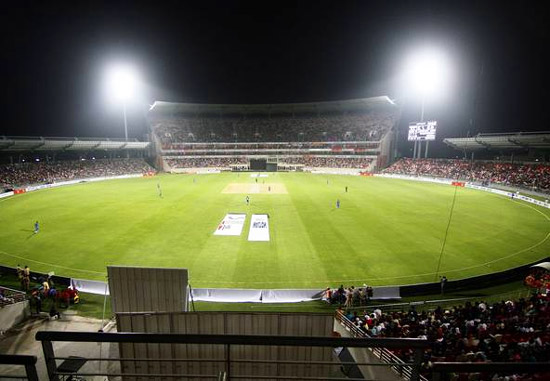 Generally, a brightness level ranging between 250 and 350 lux would be enough for players and spectators in normal cricket games. However, this isn’t quite there when it comes to professional matches, which would need a brightness level ranging between 500 and 750 lux. The brightness level should be much higher, somewhere in the range of 1500 to 2500 lux, if the matches are to be broadcasted live.
Generally, a brightness level ranging between 250 and 350 lux would be enough for players and spectators in normal cricket games. However, this isn’t quite there when it comes to professional matches, which would need a brightness level ranging between 500 and 750 lux. The brightness level should be much higher, somewhere in the range of 1500 to 2500 lux, if the matches are to be broadcasted live.
Basically, the International Cricket Council (ICC) prioritizes safety not just of the players but of everyone involved. For this reason, sufficient brightness allows the players, the referees and the spectators to watch the movement of the ball even if it travels at extremely high speeds.
c. Lighting Design of a Cricket Field
While the ICC doesn’t offer standard specification for cricket field lighting, traditional cricket field lights have been designed on long poles or way up. This is because the ball can sometimes travel too high when hit and the high lights are vital in keeping the ball in sight for everyone involved. Another important thing to consider when designing lighting for cricket fields is to ensure that the players and the spectators aren’t in direct view of the light source.
To this end, there’s not a doubt that the correct level of brightness is of great importance when lighting a cricket field. However, the most important part of lighting a cricket field is to ensure a complete natural feel for the players, the spectators and everyone involved. In fact, it’s often advisable to use LED lights given that they’re energy efficient and can produce a lamp-color rendition that’s close to daylight!

4. Basketball Court Lighting
Who says that sports are now only a daytime option? If you are someone who is passionate about basketball, and simply loves shooting hoops after a long stressful day, then there is no need for you to feel bad and complain about long work hours. All you need is a great court in your backyard with some quality basketball court lighting.
a. How good lighting helps?
It is not sufficient to just have any kind of lights in a basketball court. While basketball can be pretty safe in a controlled environment, it can also get very dangerous if the simple safety rules are ignored. It is important that while assessing the basketball court lights, you also consider various factors that could affect visibility.
Reflection from the surface of the court, choosing the wrong colors for the walls in case of a closed court which can refract and scatter light in all directions, natural lighting from the sun during daytime, and reflection from the snow in case your location gets a lot of snow during winters are some factors that must be considered before choosing the brightness of the lights for your court.
Too much light can also impair visibility and they can make you feel extremely uncomfortable and can cause you headaches. Sometimes, due to too much of reflection, you may even misplay a shot, and get seriously hurt or injured. Thus, it is vital that you get an expert to take care of doing the setup for you.
b. Getting the setup done
It is not necessary that you get the complete work done by a professional. If it isn’t in your budget, you can do some of the work by yourself – like getting the court painted, and the walls are done. For the actual basketball court lighting, you can hire specialists who would complete the job in less than a day’s time. Since they charge by the hour for setup apart from the equipment, it would be best if you planned everything in detail, and got all the necessary things ready so that they complete their job quickly.
However, if you are serious about your basketball practice, and wish that it becomes more than just another part of your backyard, then you can look at packaged services. This comprises of every single thing involved, right from planning the space, the landscaping of the court, the colors for the walls and the floor, and the placement of the lights. They assess the area first and then give you a solution which would be perfect for your requirements. They would also ensure that all the safety aspects are taken care of.
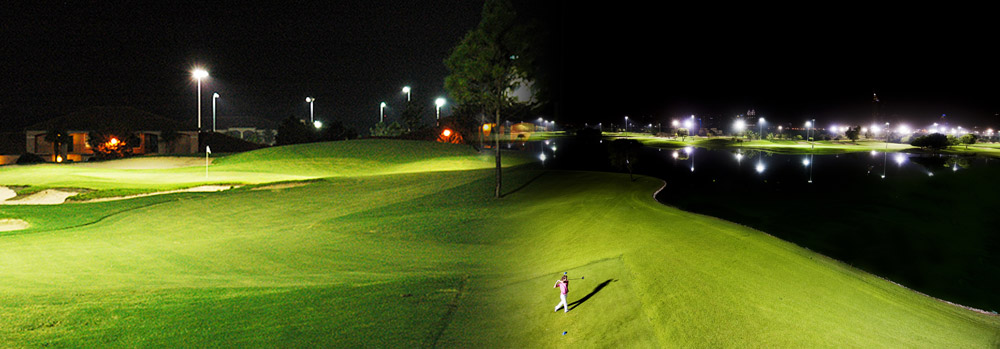
5. Golf Course Lighting
While there’s nothing wrong with playing golf during daytime, playing it under the lights after darkness has always been a novelty especially in areas where the climate tends to be cooler at night. Despite this uniqueness, illuminating a golf course is never easy if you don’t know how to go about it. This is because most golf courses are generally not designed to be lit. With the right knowledge however, it can still be attained.
a. The brightness level of golf course lighting
When lighting a golf course, the main priority always revolves around making the golf course as comfortable as possible for the players and spectators. This therefore brings one question to mind; how bright should the golf course be? For those not familiar with lighting jargons, brightness is always measured in terms of lux, and that’s what should be considered when lighting a golf course.
In golf, the brightness level will affect how the players and spectators see the golf trajectory. For this reason, it’s generally advisable to ensure that the horizontal brightness of a golf course ranges between 80 and 100 lux. Given that the flight path of the ball can also go up fairly high, there should be a vertical brightness ranging between 100 and 150 lux. This vertical brightness will give both the players and the spectators the chance to sufficiently see the entire flight of the ball all the way until it drops even if it’s running at a speed of 200mph!
b. Uniformity levels and hitting area lighting
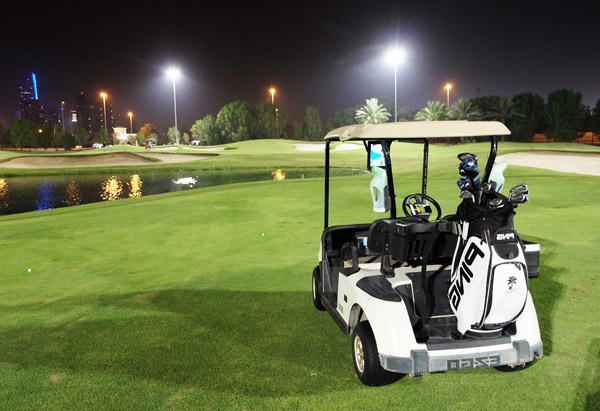 When lighting a golf course, it’s important to ensure that light is uniformly spread in such a way that it’s not too bright to affect the players and the spectators or it’s not too dim to make playing challenging. In that regard, lighting should be installed in such a way that the player doesn’t produce shadows, especially in the hitting area. For this reason, it’s always important to ensure that lighting aims at the playing direction and is done in the same way as it’d be done in a residential environment, except that it has to cover a far greater distance.
When lighting a golf course, it’s important to ensure that light is uniformly spread in such a way that it’s not too bright to affect the players and the spectators or it’s not too dim to make playing challenging. In that regard, lighting should be installed in such a way that the player doesn’t produce shadows, especially in the hitting area. For this reason, it’s always important to ensure that lighting aims at the playing direction and is done in the same way as it’d be done in a residential environment, except that it has to cover a far greater distance.
c. Reliable lighting
Another important part of golf lighting is reliability. You do not want to install the kind of lighting that would flicker, especially when play is underway. This will seriously dent play and both the players and spectators might miss those crucial moments that golf is known for. Again, you’d want the type of lighting that’s not detrimental to the eyes while still being energy and cost efficient, as well as durable. In that regard, you should always consider using LED lights when lighting a golf course since it has all the above-stated features.
Installing lighting in your golf course isn’t just about extending play time. It’s about offering a better experience for both players and spectators, and also about investing in the future – one that encourages playing golf at night! No matter the plan or design, golf course lighting should always place priority on players’ comfort, as well as those of the spectators.
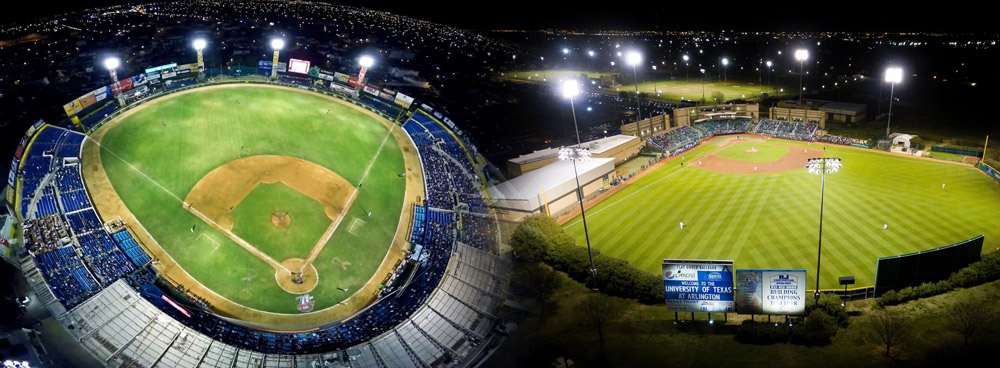
6. Baseball Field Lights
All baseball fields play a distinctive role when it comes to providing a wonderful familiarity on the sports field. Installing an excellent quality sports lighting system on your athletic field and in this case, a baseball field will give a lot of benefits to the players as well as the fans. This includes the safety of athletes, improve the experience of the fans and also flexibility when scheduling for practices and games. When you decide to light your household batting cage or commercial ball field, consider the field maintenance plans and the budgets as well because they may change to contain any additional play.
a. Quality lighting for baseball players and spectators
Visitors and spectators always enjoy a great experience in a well-lit baseball field. Besides the great experience that the baseball stadium lights provide via the excellence light output, they also provide ample energy savings for the playing fields that pay to manage them. A baseball filed may consist of both outdoor and indoor lights. When we hear of indoor baseball field lights, what comes in mind is the bathrooms, the hallways and also the concession areas while outdoor lighting, we think of the stadium lighting which hits the field. Proper light direction and illumination are fundamental in baseball stadiums, and since a baseball can move for miles per hour in the course of the game, ensure that the field is lit evenly because this allows maximum visibility to both outfield and infield activities. It’s also very essential to ensure that you avoid a direct glare to the athletes from the light sources.
b. Different types of baseball field
Keep in mind that the lighting requirements for any baseball stadium depend on the type of play, be it a small league, high school league, college league or a professional level league. Today the LED technology has become very popular and is widely being applied to the sports fields industry. There are multiple reasons as to why it has increased popularity. Major League Baseball has endorsed a sustainability movement which focuses on energy efficiency and this one of the reasons they are embarking on using LED lights in their fields. If you having to light up the indoor or backyard batting cage, it takes less amount of lights; besides, the lighting requirement will not be so rigorous.
c. Advantages of using LED lights
LED system will reduce the cost of lighting making it more sustainable and practical, and this will help save energy to about 70 to 80%. The LED technology also comes with better experience. You realize that most of the spectators go to the stadium expecting a good experience and the field lights today are creating a perfect experience making spectators attending to enjoy the game.
You will agree with me that a stadium will never be fun without security and that is where stadium lights come in. Baseball field lights play a major responsibility during visibility as well as motion detection, hence enhanced security efforts. It is crucial when your fans and visitors feel secure with the proper security and lighting measures at the same time maintaining a proficient public view.
7. Volleyball Court Lighting
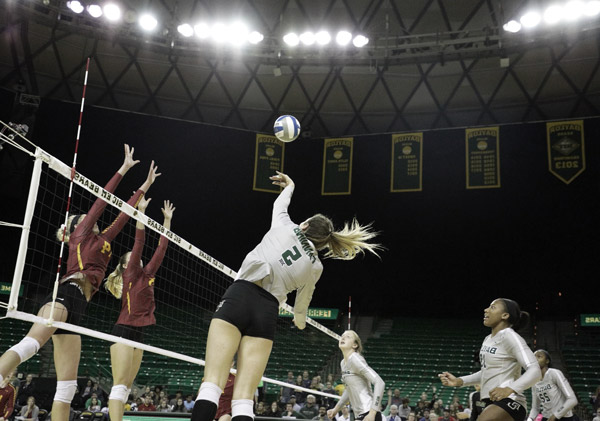 Whether it is a recreational activity, or an international competition, the lighting on a volleyball court should be uniform and sufficiently bright. Generally, low-level matches require LED lights with a brightness of up to 200 lux, while top-level competitions, such as World Cup, and Olympics need a lighting system with a brightness level of 500 lux, and a uniformity task of >7. Uniformity has an important role during volleyball matches. Fields that are dim in some places, and too bright in others will create discomfort to spectators, and confuse players. Thus, each court, no matter its nature, should have a uniform lighting plan.
Whether it is a recreational activity, or an international competition, the lighting on a volleyball court should be uniform and sufficiently bright. Generally, low-level matches require LED lights with a brightness of up to 200 lux, while top-level competitions, such as World Cup, and Olympics need a lighting system with a brightness level of 500 lux, and a uniformity task of >7. Uniformity has an important role during volleyball matches. Fields that are dim in some places, and too bright in others will create discomfort to spectators, and confuse players. Thus, each court, no matter its nature, should have a uniform lighting plan.
a. Quality LED lights
During professional competitions, flicker-free LED lights are used to allow capture high-speed shots. This allows for quality photography made by spectators, and improves the television broadcasting. Anti-glare feature is also often embedded in the luminaries on the volleyball courts. The floodlights have a special coat that prevents glaring, which can blind players while they are following the ball in the air. Outdoor courts are more exposed, needing more precaution measures. They are equipped with weatherproof lights that are meant to provide protection against rains, and excess heat from the sun. Also, outdoor courts can be illuminated with sodium lights, whose yellowish UV hue keeps mosquitoes at bay.
b. Pole arrangement inside volleyball court
Depending on the purpose of the volleyball court, lighting systems can be installed in several ways. Amateur venues are equipped with 4 poles, one pole in each corner of the court. Professional venues, though require more lighting power. This is why, they have 8 poles spread uniformly around the perimeter of the court. Poles also vary in terms of height. If they are high, they need LED lights with more power, or more sets of luminaries with lower-power LEDs. Another type of lights that are widely used for volleyball courts are metal halide lights that give off a powerful white illumination.
8. Badminton Court Lights
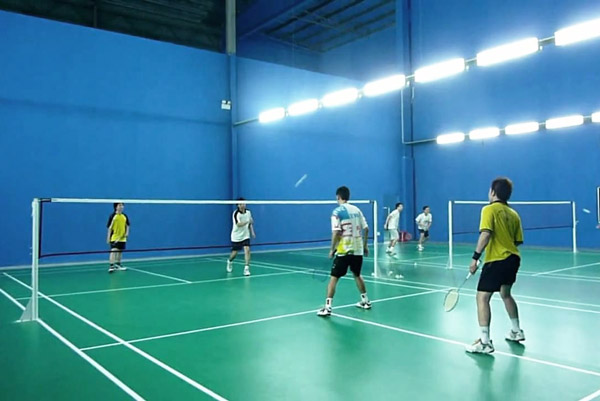 A well-lit badminton court will help to attract the right players in addition to ensuring that anyone on the court has sufficient light to exercise without getting injured. Badminton lighting must meet international standards in addition to ensuring uniform illumination, having no glare and exhibiting no strobe effects. The following are a few tips to help you choose the light righting for your badminton court:
A well-lit badminton court will help to attract the right players in addition to ensuring that anyone on the court has sufficient light to exercise without getting injured. Badminton lighting must meet international standards in addition to ensuring uniform illumination, having no glare and exhibiting no strobe effects. The following are a few tips to help you choose the light righting for your badminton court:
a. Life span
Choose long life lighting that will last for a number of months or years without requiring replacement. A good option is LED lighting which typically has a rated life of 50,000 hours. Used only 12 hours a day, good LED lighting will last up to 11 years without having to be changed. This will help you save on costs in addition to ensuring that your badminton court is well lit without fear that the lighting will go out anytime soon.
b. Ceiling height
A badminton court must be high enough that it does not interfere with the shuttle serve. In addition, it must meet the ceiling requirements of24 to 29 ¼ feet used by most countries. As a result, choose lighting that can be used on a ceiling of this height without compromising on illumination. Remember that due to glare, badminton lights should not be placed directly above the playing area.
c. Indoor or outdoor use
Badminton courts are located both indoors and outdoors and it is therefore important to take this into consideration when choosing lighting. Outdoor lighting must be hardier and adaptable to various weather conditions. Indoor lighting on the other hand needs to be brighter and longer lasting because of darker conditions and heavy-duty use.
d. Lighting balance
Proper badminton lighting makes use of both natural and artificial lighting. During the day, natural light use is maximized in order to make energy savings. The amount of natural light available should act as a guide when selecting the right badminton lights. Since you are most likely going to use both types of lighting, it is best to ensure that the artificial lighting is enough to complement the natural without leaving parts of the court under lit or being so bright that they blind both players and spectators.
The right badminton lights will ensure a comfortable playing experience for athletes and pleasant viewing for spectators. By using a few simple tips, you can select the right badminton lights for your court, and ensure that it is efficiently and effectively lit for the people who will be using it.
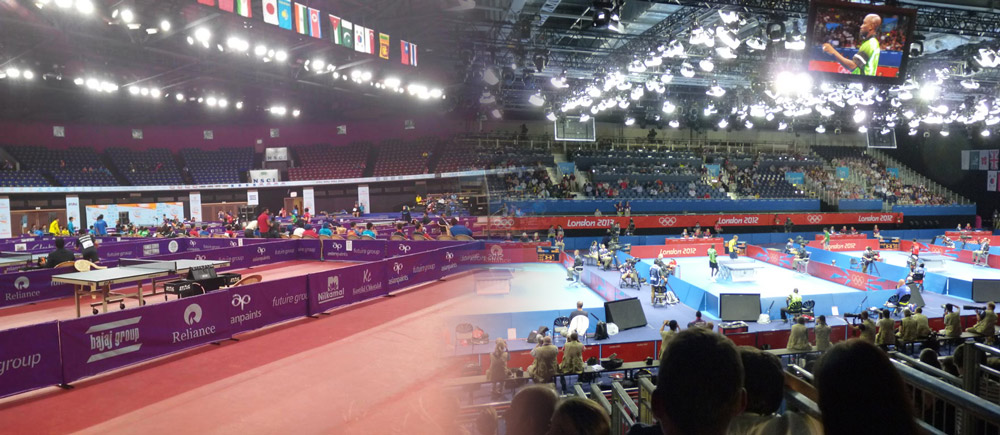
9. Table Tennis Court Lighting
Table Tennis is a game loved by many people, and public tennis courts are available for people with racquets and balls. However, a court can be added to a homeowner’s backyard, and this is dependent on a budget of the owner. The importance of lighting in a tennis play-area cannot be overemphasized as games can last till late in the evening. Making some changes in the lighting fixtures can help in improving lighting solutions for a table tennis court.
Some people also love to play some games very early in the morning before going to work and the sun may not be out at this time. Lighting a court or renovating existing lights should not be a cause for worry as the following tips will guide you.
a. Lighting points to note
The fixtures of your existing lighting should be examined while dark spots on the court should be checked. It is also important to check for glare and how the ball is well lit when moving from one part of the play area to another. You should endeavor to play after the sun has gone down so that you will be able to see how the light affects your games. Special note should be taken when some lighting fixtures cause blinding when you want to serve or return a lob.
After you have determined that you need lighting the table tennis court, you may want to look for the different styles of tennis lighting available in the market. We deliver the LED luminaries that work excellently to provide daylight kind of illumination in the court.
b. Residential vs commercial table tennis room lights
If you are designing a new lighting scheme for a tennis court, then you may first want to consider whether it is a residential court or a commercial court. The residential ones usually make use of the low-mast lights that diminish the glare and distribute light evenly across the entire court, while preventing it from going farther from the sports area. You may also consider using light fixtures and bulbs that help in reducing the glare and spreading the light evenly on the court. You may take the help of a professional to understand which lighting system is good for your court and as per his advice you can choose the right system.
Always install new lighting fixtures in the supervision of the experts so that they provide the right solution for all your tennis requirements.
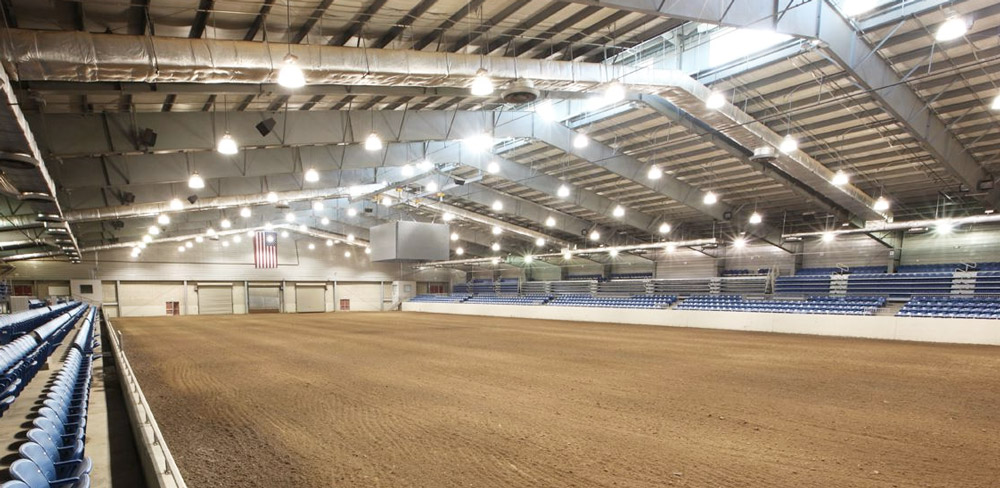
10. Horse Arena Lighting
Horse arenas could be challenging to light effectively due to their complicated designs. The last thing you need is bright lights which help riders and horses perform well during the races. Whether you are constructing a new facility or upgrading an existing area, this guide will show you some useful tips in choosing and setting up a well-lid lighting system.
a. Specific features of horse arena lighting
At first, it seems to have the same concepts as parking lots, but this isn’t actually correct. A horse arena lighting system will basically require some different features to ensure two things: appropriateness and safety. A lighting system should be able to eliminate the shadows or glares that can make it unsafe for riders and horses during the match. This requires the fixtures to be installed as high as possible to minimize the hard line between darkness and brightness. Similarly, it should ensure appropriateness by standing up to the dirt, debris, dust, and water present in the facility.
b. Recommended foot-candles
The ideal foot-candle for a casual outdoor area should range from 15 to 20, though the final decision will depend on the total size. For jumper or hunter training, the recommended level is around 40, while a competitive and training dressage should be equipped with 50 foot-candles. If you want to illuminate a competitive show-jumping area, 70 foot-candles is suitable. There is quite limited information concerning the minimum foot-candles for equestrian sports, so it will depend on your personal preferences.
c. LED and fixture efficiency
Due to the purpose and size of horse-riding arenas, the lighting system usually requires a lot of fixtures for proper illumination. This means the demand for low energy expenses is as significant as ever. And the best solution to deal with this issue is powerful and long-lasting LED fixtures. These days, these units can last up to 10 times longer than their fluorescent counterparts. In addition, they are extremely durable with glass-free designs to ensure no breakage when operating. In the long term, this will save you a lot of time and money for replacing or maintaining.
d. IP Ratings
Whether your lighting system is installed outdoors or indoors, in arenas or stables, it is necessary to choose fixtures with the right IP ratings. This refers to the ability to withstand some environmental elements such as water, dust, moisture, debris or wind. Models with higher IP ratings are often better and more expensive. Here are the three most versions that you should look for the best lighting fixtures:
- IP67 means submersible and completely sealed
- IP66 means water resistance against powerful jets
- IP65 means water resistance
11. Race Track Lighting
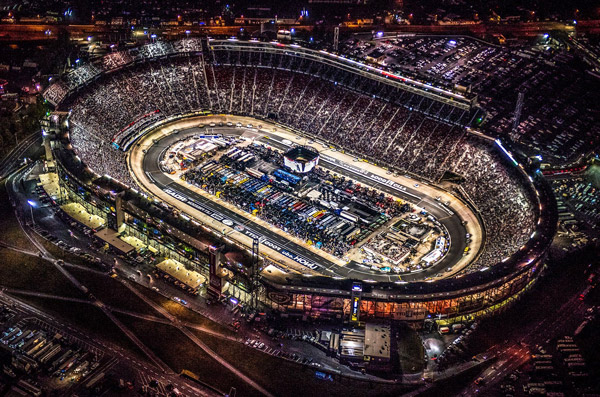 You will realize that many people who own their own tracks work in the day. This leaves them with no alternative other than racing either in the evening or on the weekends. During winter, the days are shorter meaning that dark will come knocking early and unless you have race track lights, your race will stop early because the sun will soon fade. In case of such a situation, race fans with a mentality that they can only end a race with a plaid flag will be disappointed.
You will realize that many people who own their own tracks work in the day. This leaves them with no alternative other than racing either in the evening or on the weekends. During winter, the days are shorter meaning that dark will come knocking early and unless you have race track lights, your race will stop early because the sun will soon fade. In case of such a situation, race fans with a mentality that they can only end a race with a plaid flag will be disappointed.
a. Importance of motor speedway lights
Having the perfect race track lighting is a clear picture that your next racing activities will be a great experience for all your visitors and fans. The track lighting system will add the venue’s appeal and provide accessibility and security as well. Due to advanced technology, LED lights have dominated over the LCD lighting system. These lighting systems are designed in a way they will save your energy and also have a low maintenance cost. These lighting systems are easily available to users because a number of the lighting industry manufacturers and sellers are providing them to the customers. Today, almost all race tracks are using LED lights because they are energy efficient and durable. They differ in features and benefits depending on their use.
Track racing flood lights are very crucial because they are the most used in a racing activity. What closes your mind when you think of it? Track racing includes horse race, car race, motor cross race, athletics, cart race, greyhound and many more. The installation requires to be carried out by an expert electrician. When installing this high level of electricity, one has to consider the infield and outfield lighting activities. The infield lighting system should light the entire sports arena giving the fans a clear vision of the events happening. These indoor lights should be set in a way they would disrupt the vision of the competitors. The outdoor lighting system includes the car park lighting, office lighting, entrance lighting, finish line lighting, garage lighting, broadcasting lighting and many more.
b. Why using LED lights for race track
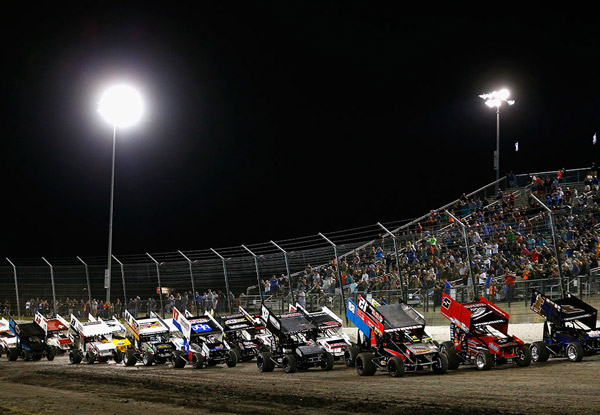 LED race track lights will keep the track lit for 9-years plus without having to worry about them. The field lights are also very easy to use because you can install them to any height and since they have a long life span, no replacement will be required any time soon. The moment they are fixed, you are guaranteed that they will last for years without any maintenance. Lighting for racetracks and in our case, the LED lights are the best because they consume less electricity. This is an added advantage because track owners can easily afford them and since track racing is an event that takes place even in the late hours of the night, one can save about 75% on energy.
LED race track lights will keep the track lit for 9-years plus without having to worry about them. The field lights are also very easy to use because you can install them to any height and since they have a long life span, no replacement will be required any time soon. The moment they are fixed, you are guaranteed that they will last for years without any maintenance. Lighting for racetracks and in our case, the LED lights are the best because they consume less electricity. This is an added advantage because track owners can easily afford them and since track racing is an event that takes place even in the late hours of the night, one can save about 75% on energy.
All these lighting systems will fulfill the desire for your track. Proper lighting helps you get the best of out of the finest architectural features that are not available in other lighting systems. The track lights vary from types and designs which match the theme and style. In case you are shopping for the flood lights, you can easily get confused or overwhelmed by the many options. However, a well-designed track lighting system has the versatility that will serve the entire filed giving the fans the best enjoyable experience in all the racing events.
12. Velodrome (Cycling Arena)
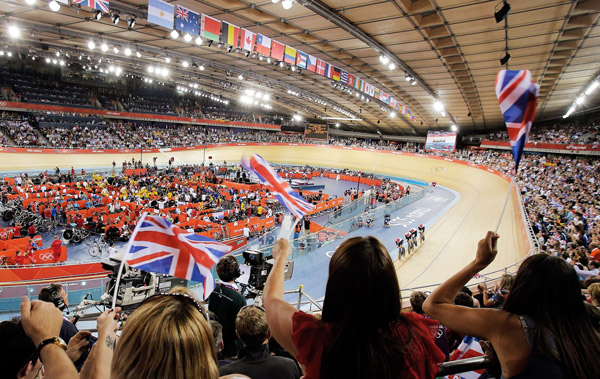 Bicycle racing has become a popular sport in many cities. However, this competition different from other general sports in terms of venue, setting and lighting equipment. A velodrome features a sloped playing field with a gradient from 13 to 47 degrees. In competitions, bicycle riders reach speeds more than 85km/h. Racers are also very close to each other that a single mistake can lead to grave accidents. So, it is crucial to install velodrome lighting. What makes these lights different from the rest is that they offer enough brightness while eliminating the glare. The cycling tracks lights are arranged uniquely to ensure they meet the different types of matches including chase races, competition races, as well as time trials.
Bicycle racing has become a popular sport in many cities. However, this competition different from other general sports in terms of venue, setting and lighting equipment. A velodrome features a sloped playing field with a gradient from 13 to 47 degrees. In competitions, bicycle riders reach speeds more than 85km/h. Racers are also very close to each other that a single mistake can lead to grave accidents. So, it is crucial to install velodrome lighting. What makes these lights different from the rest is that they offer enough brightness while eliminating the glare. The cycling tracks lights are arranged uniquely to ensure they meet the different types of matches including chase races, competition races, as well as time trials.
a. Lighting for cycling track
These lights are also different from ordinary track lights. They are designed to offer the right lighting levels at the same time enhancing the visual environment of the athletes, match officials as well as the spectators in the venue. To make this possible, these lights have a reduced glare, as they minimize the lighting shadow in front of the racers in the Velodrome. Velodromes are also filled with cameras that monitor the performance of the athletes. For this reason, it is crucial to ensure that the arena is fitted with non-flickering lights. This enables the audiences watching the race from television to get clear pictures. At the same time, these lights must meet the correct illumination ratio, gradient, and three-dimensional lighting.
b. Top-class standard lighting
Bicycle track lighting is not only designed to offer an impeccable performance during the race, but they also need to meet the requirements of large-scale world-class tournaments. To achieve this, the lights come with various switch modes that are customizable to deliver the desired results. As you might have guessed, most of these lights are LED. One of the main advantages of LED lights is that they are energy efficient. They also come with a longer lifespan, making them easy to maintain.
c. Types of lighting used in velodrome
Besides the track lights, a velodrome is also fitted with high suspension LED ceiling lamps. These lights come with effective reflectors. These reflectors are extremely useful as they enhance the lighting for up to ninety-five percent efficiency. By combining the convenient design and efficiency, these lights will help the velodrome owners save on energy bills. They are also economical thanks to their high luminosity and longer life span. When compared to traditional mercury, sodium lamps and metal halide lights, these lights help save energy consumption for up to fifty percent. They also deliver a well-balanced light with no glare, providing a comfortable lighting environment for spectators and racers.
Furthermore, the velodrome lighting system also includes the high-efficiency flood LED lamps. What gives latest velodrome lights an edge over the traditional lights is they have better heat dissipation mechanism. They also have a better thermal conductivity, which helps in minimizing the temperature in the LED junctions. Besides prolonging their life, minimal heat dissipation also reduces air conditioning costs. What’s more, these lights come with a special asymmetrical light emitting diode lens that projects the light evenly on the surface. This does not only prevent light loss bit also improves light utilization, making it ideal for both outdoor and indoor stadium lighting.
13. Gymnastics Lights
A gymnasium lighting system is a very important factor in creating a friendly atmosphere that appeals to those who use the facility. The ambient lighting in the gymnasium must be enough to ensure safety of the users. Gymnasium have special lighting needs and you can select different type of luminaries like metal halide, Led or HID. Here are some factors to customize your space according to your requirements
a. Choose LED’s
You may ask if LED’s are better than metal halide in Gymnasium? Yes, LED’s are a better choice because you can decide on the wide range of color temperature that ranges from 2500 to 7500 K. You can select smaller temperature, if you want to have warm color and higher temperature of around 6000 to 7000 K, if you want to have cool color temperature. However, most users select a temperature that resembles close to natural sunlight, which is 5500 K. In addition, the lifespan of LED’s are usually 10 to 20 times higher than traditional lights, and are energy-efficient too.
b. Choose low glare, high uniformity lights
Gymnasiums have a lot of smooth, glossy surface, and a glare during workout is highly distracting to the users. And, low lighting areas in the gym can make your client feel low-energy. To fix these issues, choose lights that create uniform brightness throughout the area like lights with wide surface areas.
c. Choose appropriate lumen output lights
Workout area is one of the most crucial areas in a gym due to the fact that it is where users spend most of their time. Choosing a light with appropriate lumen output is highly essential in these areas. During a workout, most users need gentle level of brightness, and if the lights are too bright, it will create discomfort to their eyes or cause distraction. To minimize this, choose appropriate lumen output and combine it with other tactics like diffusers and milky or frosted lens covers. Yet another way is to cast lights upwards, rather than casting it downwards.
14. Snooker Table Lighting Fixture
Snooker table lights represents more than ambiance, as it is intended to provide the illumination needed to play the game. If you think that your regular ceiling light will work for your snooker table, then you are wrong. The snooker table lights are designed to spread light evenly across the table so that the balls are clearly visible and minimize glare.
Here are a few things you need to keep in mind before buying a snooker table light fixture:
a. Design of snooker table lights
Most well-designed snooker table lights will have 1 to 6 shades which are around 52 to 62 inches long. There are no strict rules regarding snooker table lights because these tables are available in various sizes. For a 7 to 8 ft. table, a 50 to 60 inch long light would suffice. However, pay attention to the quality of lights so that the glass won’t shatter all over the table when you accidentally hit it with the cue.
b. Brightness
Having the right brightness of light will prevent any annoying glare and deceiving shadows being cast on the snooker table. Too bright lights will irritate and cause glare, and too dim light will affect your depth of perception during playing. Most snooker table lights allow the use of 60 Watt bulb, but it is not uncommon to use a 40 Watt bulb if you find a 60 Watt bulb to be too bright.
c. Hanging the light
Setting your snooker table lighting at the correct height is essential. When you set it too high, you are going to blind yourself and your opponents, and too low, you are going to hit the light shade with your cue after every shot. Hang the lights 60 to 63 inches above the floor or around 30 to 36 inches above the green surface of the table.
d. Center the lights
In addition to hanging the snooker table lights at the right height, it is essential to center your snooker table lights correctly. If the light is not centered, it will cast odd shadows and angles during your game.
15. Soccer Stadium Lights
Soccer is the most popular sport in the world. With billions playing and enjoying it around the globe, it is no wonder that soccer fields need to have proper lighting. After all, it is hard to organize games, especially professional ones without having the ability to play once the sun goes down. Fortunately, with the use of soccer stadium lighting setups, any pitch can have as much light as its teams, officials and spectators need. In this regard, there are two big categories of soccer lights that any field can employ. Here is an overview of both of these.
a. High Mast Based Lights
This is the traditional setup for any soccer lights, no matter if they are located on a small field used for practice or a top-level league team. These include a cluster of strong lights being hoisted up onto a high mast structure. This thick metal pole or a pillar of some type is used to hold the lights in place and then point them at an angle towards the pitch. Usually, there are four such locations on any field, one for each corner. This makes sure that the goal line on both ends is properly illuminated, while the center of the field gets enough light from each of the light clusters. Today, the height of the mast can differ and provide different weight-bearing characteristics. This way, even small training pitches can get light from smaller masts, or more than four masts can be used on a field.
b, Stadium Based Lights
This lighting setup is possible when a pitch is surrounded by some type of stadium. When it is present, numerous individual lights are positioned inside of the stadium structure, usually the edge of its circular roof. This way, a halo of lights that surrounds the pitch is created. It produces great illumination and almost no shadow direction, unlike the mast-based light setup.
With both of these setups for soccer stadiums, the same sport is able to make sure that its games are well-light at any time of day or night.
16. Hockey Rink Lighting
A hockey rink can either be indoors or outdoors. But no matter the place, it should always offer a conducive environment for both players and fans. Therefore, installing a good source of lighting makes sense in whichever case. So, if you’re searching for a high-quality illumination to complement the fast-paced games or simply want to learn, then you’re at the right place. Here is what you need to know about hockey rink lighting;
a. Light distribution and color temperature
In the game of hockey, top-notch lighting takes center stage to help players hit or stop their target, that too at a faster rate. Therefore, consider installing a uniform set of lighting to avoid confusion and make seamless transitions. And as for the color temperature, the ideal choice should be one that resembles daylight. This offers uniformity, especially if the game is going to be broadcasted live on TV as they make filming much easier. And this can be achieved by the use of LED lights.
b. Light direction
Since the hockey arenas can also be used for other activities such as ice skating, having flexible lighting sources comes in handy during such times. You can easily pre-set the levels and various patterns according to the needs of the games at hand. Also, LED flood lights, for example, make it easy to direct the brightness where it’s needed; the ice and the benches, while seamlessly excluding other areas such as the seats. The beauty that comes with it is outstanding; magnificent.
c. Beneficial digital lighting
With the presence of the energy saving, cheap to maintain and versatile LED lights, both teams and Arena owners can now rest easy knowing that they have found a solution for a lifetime. They beat the traditional metal lights by far. In fact, they are now popularly referred to as an all-inclusive package. No more shadows, but more fun in the game.
17. Swimming Pool Lighting
People like to swim, even if it is in a swimming pool and the enjoyment of taking a dip can be extended at night. But for safety reasons, many are limited to swimming at night. This is especially true for children since taking a dip in the pool at night is not ideal as many problems can happen. In most cases, many often have difficulty seeing in the dark let alone see what others are doing. But the existence of swimming pool lights can make it possible for adult and children to swim at night.
a. Color of Lighting
There are different things you need to consider when choosing the right pool light. Firstly, you need to decide what color you want your light to be. Are you getting your pool lighted just so that you can see better while swimming at night? If so, then perhaps plain white or yellow colored lights will work for you.
On the other hand, if you are looking to beautify your pool, then there are loads of other colors for you to choose from. You can even purchase lights that change color after a certain period to provide variety to the colors in your pool. You might want to hire an engineer to help you choose and to be the one to assemble your lights. Remember that electricity and water is not a good match. One mistake and you could end up electrocuting yourself.
b. Long-lasting Swimming Pool Lights
You should also make sure the light lasts a long time so that you won’t have to call in the engineer to change the light bulbs too often. Now that you have a better idea of how to add beauty to your pool with swimming pool lights, you should start researching on them now.
Proper lighting is very important in the swimming area, especially at night. Resorts have to install these underwater lighting supplies to make sure that there are no guests present while they are conducting their routine nighttime maintenance.
c. Safety for Swimmers
Aside from this, swimming pool lights will certainly ensure the safety of their swimmers. Guests often have no idea where the deeper end of the pool is. If the swimming area is lighted, they can correctly gauge the depth of the water. Another important thing is that the lifeguards present will be able to see clearly if anyone needs help inside the pool.
At home, this is also very important. Having underwater lighting supplies will ensure that homeowners know they’ve reached the far end of the pool. This is essential so that they don’t bump their heads right into the wall. When you have children at home, you can make rounds at night and be sure that there’s no one inside it.
Pool lights, aside from bringing safety to the area, can also add some style. These supplies can be availed in several colors. You can have the standard blue water or go hip and funky with pink, yellow or green glowing lights. The vibrant lights will add some life to your evening pool party. If you have formal evening parties at home, the wonderful pool lighting that you have can add pizzazz to your backyard area.
LED Sports Lights Design
1. High Power Lighting for Large Stadium (Lumen Requirement)
Generally, fast action sports, particularly those involving small lighting objects like cricket balls and longer viewing distance require higher lighting levels. The slow speed and large objects (football) and close viewing distances require low lighting level. Outdoor sports lighting helps achieve supervised training, national, club, CTV, or international coverage. Various lighting guidelines and specifications recommend various levels for individual sports. Some sports bodies provide their specific lighting specifications too.
Generally, lighting supply has three classifications – the amateur stadium lighting, the semi-professional lighting, and the professional stadium lighting. The various factors that differentiate the stadiums include the uniformity, ground lux and whether the sports are to be televised or not.
a. Class 1
The FIFA and UEFA lighting guide classify the training and recreational use grounds as Class 1. The grounds have nearly 200-lux horizontal illumination and around 0.5 uniformity. Some high school stadiums and sports lighting fall in this category.
b. Class 2
Stadiums in this category include some clubs and leagues stadiums with around 500 lux and around 0.6 uniformity. That is the football field lighting standard. The regulation also applies to the semi-professional stadiums.
c. Class 3
The Class 3 stadiums include those that hold national games with around 750 lux horizontal luminance and around 0.7 uniformity. The standard is for professional stadiums, but those that are not ready for TV broadcasting. Some Class I stadiums might hold televised matches particularly those with above 1000 lux levels.
The highly professional stadiums – those used for televised national and international games – have a ground lux that changes from 1000 lux to 1500 lux and the uniformity ranges between UI at 0.1 and U2 at around 0.8. Such grounds have cameras to broadcast any big event. Therefore, the fields should have higher quality lights.
The exterior lighting levels are lower than the daylight levels and are usually low than for the same sports played in indoor settings. That is because the subject contrast is higher outdoors, with the adaptation levels and dark sky backdrop. The illuminance levels highly depend on the difficulty level of the task.
2. Flicker Free Lighting for 4K & 8K TV Broadcasting
Proper lighting is crucial for sports broadcasting, especially with the advent of 4k and 8k televisions which show HD pictures and allow viewers to take in even the minutest details in a picture. Today, cameras must let in not only the right amount of light but also ensure that the quality of light they use correctly depicts the colors on the ground in addition to adhering to the Television Lighting Consistency Index’ set out by the European Broadcasting Union. Flicker-free lighting not only meets these standards but also offers the following benefits for UHD sports competition broadcasting:
a. Enhanced experience for viewers
Flicker-free lighting allows cameras to capture every single moment in a sports competition which means that fans can enjoy the full experience of a game. In addition, viewers have a clearer view of what is happening as they will not be distracted by flickering lights which ensures that they enjoy the game even more.
b. Greater picture quality
Flicker-free lighting also ensures a glare-free experience for broadcasters which allows them to pan further across the field and results in a clearer picture overall.
c. Lighting uniformity
Broadcasters can enjoy greater vertical and horizontal uniformity since they will not have to worry about adjusting lighting and cameras to avoid flickering lights.
d. Clearer TV broadcasts
Flicker-free lighting is designed to ensure the production of high-quality pictures that work best with UHD TVs’ such as 4k and 8k. This allows viewers to see even the smallest of details and also allows for playbacks so they can replay their favorite moments
Flicker free lighting ensures a clear, high definition and enjoyable experience for 4k and 8k television users. In addition, broadcasters can ensure greater picture quality and lighting uniformity in order to give their viewers an unmatched sports competition broadcasting experience that will ensure that they keep coming back for more.
3. Anti-glare Illumination for Sports Players
Participating in sporting activity in the presence of external light sources such as the sun or bright light facility lighting can be stressful especially for athletes. Moreover, according to most lovers of sports, it is the potential reason for performance errors.
a. What is glare
Two types of glare effects can result in disruption of performance. Namely,
•Discomfort glare – shielding one’s eye or the urge to look away
•Disability glare – a more serious issue that leads to loss of visibility of particular objects
b. Effect of glare for athletes
Some of the objects that an athlete may not see include those that have low contrast relative to the background, for example, a white ball in a background of fans wearing light-colored attire. Other factors may include the angle as well as the spectral distribution of light. It is in this regard innovative anti-glare solutions have since been introduced to both pro and amateur athletes to ensure the effects of glare is limited.
Anti-glare lighting is one such innovation that has significantly played part in helping sports people compete in ideal lighting environment. This is an expert light distribution technology with stable lighting performance. And, apart from the benefits of “friendly lighting”, anti-glare lighting is more energy efficient and also good for the cameras.
The technology is scrutinized, designed, and built to reduce glare and provide balanced, comfortable lighting in the pitch. It comes with adjustable illumination field and an anti-glare system, which reduces stadium-operating costs and provides a stable lighting performance.
Apart from the athlete perspective – anti-glare lighting for athletes, there is also the perspective of the spectator. It delivers a great entertainment experience without witnessing lighting issues during play. User experience is key in every sporting event and it is, for this reason, stadiums should focus their energy on investing in the ideal glare-free lighting system. The lighting systems come in various sizes and prices depending on space and budget as well. Seek the advice from our engineers for more insight on anti-glares lighting units before purchase.
4. Installation Height of Sports Lights
Both professional stadium lighting and amateur grounds such as school stadiums, lighting mounting have to comply with the scientific methods. UEFA and FIFA standards require LED lighting installers to consider various installation aspects such as the pole quantity, the field size, pole height, and the expected ground lux.
a. Four corners guidelines
In four corners lighting, the stadium lights installers have to locate the masts in four corners of the stadiums. The light beans will converge from these four corners to the stadium’s center. In such cases, the installation masts should be as high as possible – in case of professional stadiums – so that the light can travel more efficiently to the center part of the stadium while maintaining uniformity and good anti-glare.
If the masts are very low, the light might not reach the middle area and keep adequate brightness – the distribution of brightness will suffer. To make uniform lights, you should stick to an installation height around 30 meters in the Class 1 stadiums. That way, you will enjoy higher quality projection.
b. Four poles at the center of the stadium
This method of stadium lights installation involves the installation of four masts at the center part of the stadium – on two sides. The light beams travel from the four masts to the entire stadium. Therefore, during the design phase, the installers have to consider the four corners. The mast has to be high but not as high as expected with the four-corner lighting method.
c. 6-8 pole distribution
At times, people choose to install 6-8 masts. In such cases, the height of the mast should not necessarily be very high because the many poles allow for uniformity and better distribution of light. In training courts, high school and college sports lights installation, you are likely to find 8-12 meters high masts. The installers place the 6-8 masts in equal distances and designing for the light distribution is easier when the masts are more. On the downside, you will have to spend more on the poles or masts. Taller masts are more expensive than short ones. Therefore, you have to consider all the factors carefully during the installation.
5. Color Temperature
How color temperature in stadiums affect the mood of sports players?
There are many types of researchers who have conducted studies that prove that lighting color can affect your mood. Even without a degree in psychology, we know about Seasonal Affective Disorder and the sadness that can creep in during the cool, dreary winter months.
When the sun comes out, moods can drastically change for the better. Using the knowledge of the power of color psychology and color temperature, designers and architects of the world can create offices, homes, buildings and sports stadiums that are designed to produce positive effects on the people who will be spending time there.
a. Light therapy
Light therapy studies have determined that different light colors can affect not only people’s moods but their heart rates and circadian rhythms as well. Different intensities of light can cause the body to release certain hormones. It only makes sense that the amount and type of light can affect performance for both fans and sports players as well.
b. Higher vs lower color temperatures
Higher color temperature has been known to release serotonin which can positively impact our moods. These color temperatures help to create a vibrant and refreshing mood for people who are under them.
A lower color temperature, in comparison, will produce melatonin, the hormone that helps us to unwind and relax at the end of a long day. These color temperatures provide feelings of coziness and are great to use when you want to welcome people to your home.
c. Determining color temperature
The color temperature of any light source is measured in Kelvins, a primary unit of temperature measurement. Color temperatures over 5000 K are considered to be cool colors, while lower values (2700-3000K) are considered warm.
d. New era of LED lighting for stadium
Why should the theory of color temperature apply only to offices and homeowners, though? A new trend that sports fans are coming to take note of is that stadiums and sports arenas are slowly beginning to install LED lighting systems. Not only do these LED lights provide facilities with a whopping 70% savings on their energy costs, but they provide an enhanced experience for both the fans and the athletes on the field. Sports lighting can improve the presentation of the game and provide crystal clear replays on the big screen, all enhancing the viewing experience for the fans in the crowd.
The athletes, on the other hand, also appreciate the switch to LED lighting systems in the stadiums. Improved lighting helps the players to perform better and goalies are especially able to appreciate the brightness of the LED lights as it helps them to track the ball better. When the stadiums are brighter, it allows the release of serotonin in the players which will not only improve their mood but their performance levels as well. In stadiums that have lower color temperatures, the fans are not only not as excitable about the game at hand, but the players are also more likely to experience releases of melatonin instead of serotonin.
If the owners of sports teams with their players to play their absolute best, we recommend they let color theory worth with them instead of against them and consider installing LED lighting systems in their stadiums and playing fields.
6. Color Rendering Index (CRI)
Not all lights are the same. Many mediocre incandescent and LED lights available in the market utilize less energy but emit white light which is of extremely low quality. In stadiums and field photography where appearance and quality are of paramount importance, you can’t compromise the light quality and go for low CRI. Precise and accurate discrimination of colors is crucial in visual arts and photography and that is where Color rendering Index plays a vital role.
a. What is the CRI?
Color rendering index or CRI is the measure of the accuracy of the object colors when it is illuminated by the light source. The index is measured in the range of 0-100 where 100 represents the perfect illumination of the object under the light source. This means that the object will appear the same as it would appear under natural sunlight. In short, CRI gives a measure of naturalness, vividness, preference, hue discrimination, and color accuracy. Low Sodium vapors lamps have CRI close to 0 while high-quality incandescent lamps and LED lights scores close to 100.
b. What is a good CRI score for LED sports lighting?
While buying LED sports lightning, you must take CRI into account. It is essential to go for a high CRI rating of 90+ when an accurate color presentation is a must. A score greater than 80 is acceptable for most of the sporting applications but for detailed photography and true video streaming, you must aim for a CRI score over 90. A score greater than 90 is considered as “High CRI” lights. Such lights render beautiful vibrant color tones across the entire color spectrum. Also, you can blend high CRI and color temperatures in LED sports lights to achieve the desired configuration.
However, CRI is not the stand-alone parameter to consider. Energy consumption and light durability matter as well. But CRI is one of the most important factors while buying LED sport light fixtures.
7. Waterproof Outdoor Lighting Fixtures
Waterproof lighting fixtures bear certain characteristics that make them ideal for outdoor sports. Not only are they bring tough and durable, they also have powerful bulbs and are easy to install.
Here are a few good reasons why LED is suitable for outdoor sports fields, and why they are better than most other types of lighting fixtures.
a. Our LEDs Are Waterproof
The best thing about waterproof lighting equipment is the fact that they are can withstand moisture. They will continue to work despite rain and strong winds. Furthermore, they can also withstand snow and extreme temperatures, all of which are quite common in most outdoor stadiums and sports fields. So, if there’s one reason why you should get waterproof lighting for an outdoor sports field, it’s the fact that they durable and waterproof.
b. They Last Longer
Waterproof lighting equipment are tough, but they also last for a long time. A durable, waterproof lighting fixture can last for more than a year when left on for 24 hours a day, seven days a week. However, since these fixtures are only turned during evenings, sports games and special events, they last a lot longer.
A well-maintained set of waterproof lighting fixtures can last for at least five years. At a sports center or stadium, such long lasting lighting equipment are not only essential, they can also save a lot of money.
c. Waterproof Lighting Have Parts Which Are Stronger And Rust Resistant
Aside from being resistant to moisture, waterproof lighting fixtures have durable and rust resistant components. These apply to their power supplies, their adapters, their optics and whatever other accessories they may have.
Not only can these components last for several years, they are also low maintenance. A check up once or twice a year is all that’s necessary to keep them in good working condition.
8. Stadium High Mast Lighting Control
If you’re a football fan/player, then you must be aware that there’s so much more to having fun in the field than playing the game itself. Stadium lights, for example, offer a thrilling experience while enhancing security features both within and outside the stadium. In fact, they have several other applications apart from these two prominent ones. But that’s not what we are discussing today. Instead, let’s focus on how to control high mast lighting in a football stadium. See also DMX vs DALI control system.
a. Lux Level/Brightness
This majorly depends on whether you’re planning on having the game televised or not. Televised games require more light to give camera people ample time in recording, so they don’t have to keep adjusting their camera angles. For instance, for high-end competitions such as the famous world cup, FIFA recommends 2400lux as the highest level of illumination hitting a player’s face and 3500 lux as the horizontal one. But if yours is a community recreational area, then you can comfortably do with at most 2000 lux. And 500 lux goes for college or high school fields.
b. Achieving Uniformity
Uniformity is key when it comes to achieving perfect lighting in the football stadium. This typically refers to the even distribution of light across the area. And it ranges from a scale of 0 to 1. So, you should always ensure that the lux level on all high mast lights remain similar, for example between 550 to 600 so that the uniformity will be near 1, which is closer to FIFA requirement of 0.7
c. Achieving A Cool Temperature
An average football ground requires a color temperature of more than 4000K. So, it’s always safe to work with 5000K to around 6000K. This way, you will achieve a cool white illumination, which is similar to that of daylight. This is both beneficial to the players and their fans. And that should be the ultimate objective. There’s no way you can separate good lighting from a great game!
LED vs HID Sports Lighting Fixtures
1. Limitation of Using Metal Halide, Halogen and Fluorescent Lights for Stadium
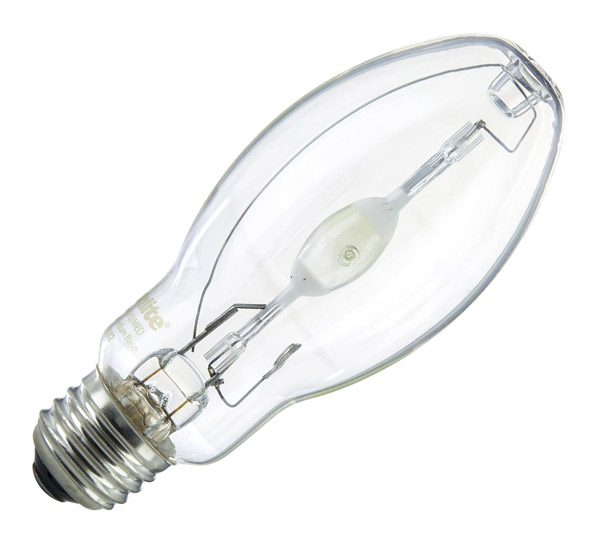 There are various forms of lighting in sports field application. These are Metal Halide, Halogen (filament), Florescent, and LED lights. All these lights have their benefits and limitation in various circumstances. In this post, we are going to look at the limitations of using the metal halide, fluorescent and halogen bulbs for sports field. We will begin by giving a brief explanation of how each light works.
There are various forms of lighting in sports field application. These are Metal Halide, Halogen (filament), Florescent, and LED lights. All these lights have their benefits and limitation in various circumstances. In this post, we are going to look at the limitations of using the metal halide, fluorescent and halogen bulbs for sports field. We will begin by giving a brief explanation of how each light works.
Halogen bulbs
These bulbs use a filament that heats up (glow) when electrical current passes through. The glow will produce light while emitting a lot of heat. In terms of energy conservation, these bulbs are energy inefficient. They consume a lot of energy leading to high operating costs.
Metal halide
These bulbs operate much like their fluorescent counterparts. Instead of the filament glowing with is the case with the halogen bulbs, these bulbs contain a gas that glows. With a basic understanding of physics, heating gas does not emit as much heat as heating metal. While these bulbs are more energy efficient, they contain dangerous chemicals in their coating, which is harmful to our health.
Now that you have a basic understanding of how each of these bulbs works. Let us look at their limitations and why they are not appropriate to use in sports fields.
a. Emits a lot of heat
The main disadvantage of these bulbs is that they emit a lot of heat. As you know, competition in sports fields involves high workout. High-intensity workouts, make our bodies to produce heat. Also, wherever there are competitions, there is a multitude of spectators. Therefore, unless you are prepared to use a lot of money in air condition a sports field, you don’t want any increase in temperature. Besides, high temperature hastens the wear and tear of the bulbs themselves. While they may be cheaper to purchase, they have a very short life span. This means you will need to replace them more often, increasing your running costs.
b. Increased maintenance costs
Halogen and metal halide bulbs are generally basic in structure and function. This makes them have an advantage when it comes to the initial cost. However, these bulbs are not energy efficient. Therefore, while the incandescent and halogen bulbs may cost less, they consume a lot of energy. This increases the monthly energy bills, making them uneconomical. Besides being, energy inefficient these bulbs last for only a few months while compared with LED lights that have a lifetime of over 20 years.
c. Poor Light Distribution
Metal halide and incandescent lights are designed to emit light in all directions. While this might sound great, it has its limitations in a sports field. For the best lighting conditions in these fields, lights need to be sent in a specific direction. This is where the LED lights come in. These lights provide more control over light control, ensuring less light is lost. Additionally, the metal halide, halogen, and fluorescent bulbs send more light towards the sky, increasing light pollution.
d. Increased glare
Glare is an uncomfortable reflection of light that makes our eyes blind. It is often produced when there is a high reflection of light on the surface or walls. Metal halide bulbs and halogen bulbs light tend to form a shadow causing a glaring effect. This effect can be dangerous in the sports field. For instance, in the soccer field, the glare may cause temporary player blindness causes him/her to miss a shot. Additionally, in a competition like biking this may cause an accident if an athlete goes out of track or collide with another competitor.
e. Health risks
The main limitation of the tungsten and metal halide bulbs is that they operated at high temperature. This can lead to accidents when used near combustible materials or if mishandled. Metal halide bulbs are also hazardous to the environment as they emit a lot of UV radiation. These radiations are known to cause skin burns or worse retinal damage. What is even worrying is that these bulbs deteriorate with time. As time goes by these bulbs, become more fragile and susceptible to bursting. Additionally, the fluorescent bulbs contain toxic phosphorous in their internal coating which is harmful to your health.
So, what’s the alternative?
LED (light emitting diode) bulbs are the ultimate choice for sports field lighting. These bulbs offer two primary benefits over the incumbent lighting technology. These include a longer life span and low energy use. Additionally, these bulbs diffuse light well, providing an optimal lighting solution to sports fields and arenas. What’s more, they are pretty much cheaper to use and maintain in the long run!
2. Benefits of LED Replacement
LED lighting also has many specific advantages when it is used in work environments. Here are some of the main reasons why is it worthwhile to replace HID solution for sports fields.
a. LED has a longer lifespan
One primary reason people are stuck on LEDs is because of how long the bulbs last. Compared to incandescent lighting, LED bulbs have more to offer, especially when longevity is concerned. People who use light-emitting bulbs may never have to change their bulbs. Incandescent bulbs last an average of 1,000 to 2,000 hours. At that rate, depending on how much you use electricity, you will have to change bulbs every two to three months. LEDs last an average of 25,000 to 50,000 hours. At this rate, people may only have to change their bulbs every five to six months, but this again is based upon how much you use electricity.
b. LED has higher energy efficiency
Energy efficiency is one factor many people are looking for when they purchase bulbs. As far as energy efficiency is concerned, when compared to incandescent bulbs, light emitting bulbs exceed them by a whopping 80 to 90 percent. Light emitting bulbs convert more than 75 percent of its energy into light. With incandescent bulbs, more than 20 percent of the light is lost due to heat and other forms of energy.
c. Eco-friendly
A lot of people are focusing their attention on helping the environment. Unlike incandescent bulbs, LED bulbs are not toxic and chemical free. Incandescent lighting contains harmful chemicals, such as mercury. Mercury is one of the many chemicals that are harmful to the environment.
d. Special operations
There are not many light bulbs that can withstand extremely cold or hot temperatures. These illumination devices have proven they are worthy by being able to withstand harsh hot and cold temperatures. Fluorescent lamps have many different issues with harsh and severe weather. Extremely low temperatures damage and destroy fluorescent lamps.
e. Exceptionally flexible
Another feature people enjoy about using these devices is the control they have over how much light thy use. If you want a relaxed and calm atmosphere, these devices can be dimmed. LEDs have an illumination system no other bulbs have. LED lighting systems have many different effects to help the user achieve different moods via the effects. These bulbs can set the mood for the mind and be beneficial to the eyes.
f. They are durable
There is nothing better than purchasing a product that lasts. LEDs last a long time and can withstand harsh conditions, such as severe weather. The durability of LEDs is the primary reason many clubs use them for Sports Field lights.
g. Cost saving
It needs to be mentioned that the cost saving benefits of LED bulbs are very important in the sports fields.
8. A range of colors
Another advantage of LED light is that they are available in a wide variety of colors to light a field on different occasions which is not possible with regular fluorescent tubes and bulbs. You do have to use filters to get different colors. Hence, it becomes extremely easy to get them in the color of your choice including neon colors. Amber, blue, green and red are four basic colors in which LED lights are available.
Lastly, improved safety is one of the most important benefits associated with LED lighting. As LED light produces no heat, it can be left on for several hours without any incident taking place, and they are cool when touched.
3. How to Replace HID with LED
Much as HID lights are suitable for certain buildings, it is not possible to deny the impacts of LED lighting. From lower long-term savings to lower initial costs, the replacement of LED lights supersedes even high-pressure sodium (HPS) and metal halide (MH). However, many people do not know how to replace their outdated HID lights with LED equivalents.
Though LED technology is very unique, conducting an easy lumen-to-lumen swap may not be the right strategy to upgrade to LED. Any person doing so will have far more light than required, which will increase their electricity bills.
Luckily, several manufacturers now provide options for replacing HID lights to LED. In general, these replacements come in two versions. One of the LED replacements uses the metal halide ballast already installed. This is simple to replace as you just need to remove the metal halide bulb and replace it with LED in that same socket.
The second version is called the ballast bypass. It needs rewiring of the fixture so that you can remove the entire ballast out of the circuit. This helps by supplying line voltage instantly to the socket.
While these two approaches help you to switch from HID lights to LED, there are important factors you should consider before/when making that replacement.
a. Mean lumens and initial lumens
Another factor we should consider is the mean lumens and initial lumens. The latter refers to the number of lumens that a light source emits once it is ignited. It is usually the most remarkable metric for lumen output. In fact, it is what many manufacturers will include on their product pages and specification sheets.
Mean lumens, on the other hand, factors in lumen depreciation. It can also consider how much the light source will fade with time.
HID and HPS fixtures have higher initial lumens than mean lumens. This is because they do not suffer from serious lumen depreciation. That is why LED lights run much more efficiently than HIDs.
b. Wasted light
Unlike LEDs, HIDs emit light at an angle of 360 degrees. Lots of the light does not escape as it is prevented by the bulky and big housings.
LEDs though are directional. This means that they emit light straight to where they point. Hence, lots of light goes exactly to where it is required. Meaning you won’t spend money on the light that you don’t use.
Due to this huge increase in efficiency, we can comfortably state that a single LED lumen might be equal to 4 HID lumens.
c. Rated life
Rated life refers to the duration a fixture can last before being replaced – usually in L70 rating. It indicates the number of running hours a fixture will emit 70 percent of its original lumens. Metal halide lights have L70 lifetimes ranging from 10,000 to 25,000 hours.
This output might sound very impressive on paper, but otherwise in reality. Their output will decrease significantly and quickly and will not supply all those lumens to space.
LED lights, on the other hand, can easily attain 100,000, 200,000 and even more than 400,000 hours. The efficacy lost through reflection or glass and rated life affects LEDs lumen output. The good thing is that LED lights are great at limiting those effects.
Conducting an LED light replacement should lead to a 50 percent reduction in energy use costs every year. Additionally, it might reduce electric demand charges. However, the impact of these savings will depend on how many lights you replace, electric rates and time of operation.
While LED technology is more beneficial than HID lights, the decision to make the change requires these considerations.
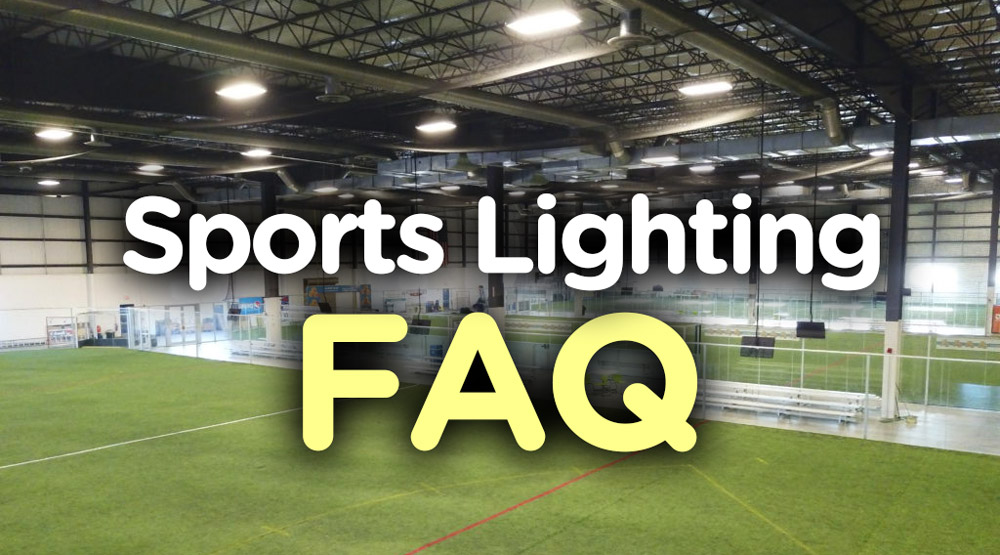
Sports Lighting Frequently Asked Questions
1. What Type of Lights are Frequently Used in Sports Fields?
A range of lights can be used to light different kinds of sports fields, however, the most widely used are the HID (High Intensity Discharge) lamps such as high-pressure sodium or metal halide.
a. LED vs metal halide
SSL (Solid State Lighting) like LED (Light Emitting Diode) is also popular because it requires less running costs and maintenance. However, an initial purchase of LED is significantly more expensive than a lumen HID of the same output. Each lamp offers different characteristics and selection of any given lamp is often based upon energy consumption, the color of light emitted, and life expectancy.
On average stadiums use higher wattage lamps when compared to other outdoor lighting applications, for example, parking lots, roadways, and billboards.
b. Application of HID
Most types of lighting can be used in a variety of applications; however, HID lights are limited to sports fields, warehouses, and industrial use. This is because they produce high levels of light. For example, most commercial and residential applications require each lamp to produce between 800 and 4000 lumens of light. A single HID lamp can produce more than 15,000 lumens.
To achieve high levels of light output, you need a lot of energy. HID lights are possibly more efficient than other types of lighting if you consider a lumens per watt basis. HID lights produce 75 lumens per watt while LED lights produce 45 lumens of light per watt.
While HID lights are very efficient, they take some time to warm up and achieve full brightness after they have been turned off. And restrike times are usually even much longer than initial warm-up times. For instance, in the event of a power blackout during a match in a stadium, after power has been restored, it may take HID lamps around 5 to 20 minutes to reach 90% brightness.
An important note though: some types of Metal Halide HID lights employ a different starting mechanism which can reduce warm-up time down to 1 to 4 minutes and restrike time down to 2 to 8 minutes.
2. What is the Lumen of Football Stadium Lights?
Lumen measures the amount of light you get from a lighting device. It is simply the intensity of light – luminous flux – where the more lumen the more the light. Stadium lighting requires very high intensity, which is best achieved by lumens.
Lumens for stadia provide the ideal level of brightness to play sport. Probably by now, you have had or heard about the great lighting experience that comes with the people and the adrenaline during late-night football. Lumen is part of that experience. LEDs today come with lumen output to achieve higher light output and very low level of energy consumption. For example, a 320w LED comes with a 41600-lumen output that is exceptional high brightness necessary for floodlights.
Modern pitches consider lumens an innovative approach of determining the brightness of light sources. According to recent research, visible light from bulbs, lamps, and LEDs is measured with lumens. A higher lumen rating provides brighter light, which is the case with stadium lights making it hard to differentiate between night and day.
3. How Many Power and Number of Pieces of Luminaries Do I Need to Light Up a Stadium?
Stadiums require good lighting that meets the needs of the audience, TV broadcasts, and participants. But how does one design good stadium lighting? Well, read on to find out more.
Good stadium lighting ensures maximum visibility for teams, referees, and spectators. Given that, designers adopt various layouts when installing stadium lights. However, factors such as pole height, size of playing field, and type of matches determine the amount and power of luminaires required.
a. Recommended Lux for Stadiums
Given the variations in sporting events, the amount and power of installed lighting vary as well. For instance, cricket matches involve fast actions, small balls, and extended viewing distances. Cricket stadiums require high illumination levels.
On the other hand, basketball and football are slower sports, have closer viewing distances, and larger playing objects. As a result, these stadiums require different illumination (lux) levels based on ball speed, location, uniformity, and desired visibility.
b. Lux levels required for different classes
Recommended stadium lighting levels have three classes: Class I, Class II, and Class III. The UNE-EN 12193 standard defines the minimum lighting levels for different sporting events. According to this specification, Class I sporting events have an illumination level of 750 lux, Class II events at 500 lux, and Class II events at 200 lux.
Besides, lights for top flight and intermediate events have a glare rating of 50, except for athletics which is 55. However, lamps used for lower flight events should have a rating of 55.
c. Bottomline
Determining a stadium optimum lighting level requires understanding several factors. These include stadium roof height, ground level, sports type, and uniformity. For this reason, selecting the right amount a power of luminaries affects a stadium’s overall atmosphere. Adequately lit stadiums are critical to the safety of fans and the success of sporting events. What’s more, installing the right number of lights creates an immersive experience in a stadium.
4. Flood Lights vs Spotlights
Which one works best for sports field?
With more and more sporting events being organized in the evening, there is a great need for proper lighting in the sports field. There has been a lot of research and development in this area and the modern-day LED lightings have replaced the conventional methods, however outdoor lights are available in multiple forms, designs and are to be used based on the requirements.
Football, cricket, hockey, tennis, rugby, and a lot other sporting events are often organized in the evening and require proper illumination. A lot of people usually get confused about the type of lighting that should be installed in a sports field. The requirements of each of these sports can differ in terms of the details, but one thing that remains common is the fact that these require distributed illumination throughout the field.
a. What are the critical parameters to considered
Multiple things need to be put into consideration when selecting lighting for a sports field. Some of these are mentioned below-
- Type of game that is played
- Visual comfort of the players as well as the viewers
- The color of the sports equipment that is being used
- Size of the field
- Shadows length being formed and their impact on the game
- Availability of lights at the entrance and exit spots
b. Flood light or Spotlights – what should you choose?
Below listed points will help you in making right choice and plan accordingly
i. Floodlights
It can provide a more substantial spanning lighting and are hence a great choice when the requirement is to cover a large area of a sports field. They can help in covering and reaching out to areas that are not easy to illuminate otherwise. Floodlights make use of LED that helps in providing superior illumination at an affordable cost. These are further subdivided into various categories and designs based on the level of brightness required and the solution used. Floodlights are installed at a suitable height to allow them to cover a wide area. They do not require much effort to set up and can be connected easily to any power source.
ii. Spotlights
They are installed when there is a requirement to produce direct and focused lighting. These lights are a great choice to illuminate doors, entrance, and exits. They direct the beam on a single area and are suitable for attracting the attention of the viewers to a particular section of the sports field. It is essential not to overuse the spotlights as it will end up spoiling the purpose. You need to use the spotlights only in areas that you wish to highlight. Installing a spotlight may require a lot more effort and planning.
Both floodlights and spotlights are very common in the outdoor lighting area, but their primary feature and usage differs considerably. To be able to make the best use of these lights, you must understand the difference between them. To ensure that the objective of providing an excellent experience for the players are viewers is met, it is recommended to have a right balance of floodlights and spotlights in a sports field.
5. Why are Stadium Lights Always On? How to Reduce Light Pollution?
Stadiums used to be situated outside the major cities. Currently, cities have expanded and many stadiums are situated in the center of residential areas near people’s gardens. Different sports are also very popular and the number continues to increase. So to cover all these sports, the clubs do play even until late at night.
That is why you’ll find most stadium lights stay on and there are reasons for that. While this is great for players and cheerleaders, it leads to light pollution. Neighbors complain about the strong lighting from these sports fields. That is why stadiums should use LED lights.
a. Switching Stadium Lights may lead to power system malfunction
Major reason stadium lights are always on is that switching them off may cause the power system to malfunction. The power framework cannot cope with the huge power spike that light switch off causes.
b. The cheerleaders and fans need that lighting
The evening shadows do make the stadium unusual. So, the lights are turned on to compensate for this. Actually, the cheerleaders practice at least thrice in a week, and they need those lights.
c. For added security
While leaving the stadium lights on all through leads to light pollution, it makes some people feel more secure. Undoubtedly, glare caused by unshielded lighting can make shadows where lawbreakers can hide. Though that is true, splendid lights can simplify the work of those lawbreakers.
d. How to Reduce Light Pollution
Light pollution is almost everywhere. It could be originating from a stadium or elsewhere. You can admire it from afar when you gasp at the skyline of your town. It might also be the annoying light on the streets that shines through your bedroom window during bedtime.
Light pollution contends with starlight in the sky. Further, it affects the astronomical views, disrupts the ecosystem and may have severe health effects. There are 4 common kinds of light pollution: clutter, glare, trespass and sky glow. All these four kinds can be reduced through the use of LED lights. Nowadays, people have accepted LEDs as exterior lighting; and this is how to use them to reduce light pollution.
i. Technological Advancement
Currently, there are 3-part lighting fixtures that emit light rays parallel to each other. Such an arrangement makes sure that the light is emitted only to the desired area, instead of lighting the entire space.
ii. The correct light with the correct angle
Lighting experts can now choose LED lights with the right beam angle enclosed both above and to the sides. This does not only channel the light downward but reduces light pollution as well. This procedure is referred to as “cutting-off light at the horizontal.” It makes sure that the light only illuminates the field.
iii. Sensor and dimming abilities
Using LEDs that have occupancy sensors is a way to reduce light pollution. These sensors do switch on and off depending on movements. Hence the ground is lit only when required. Adaptive lighting is also great for reducing light levels at specific times of night when an area is not used.
iv. Using warmer LEDs
Using LED lights with white and warmer illumination is another way to reduce light pollution. LEDs, with a color temperature of 4000k or below, are ideal.
Leaving stadium lights on all through is beneficial in different ways as discussed here. However, the stadium managers should be mindful of neighboring residences and businesses. They should understand the fixture and LED lights that are right for their sports fields before making the installations.
6. How Much Does It Cost to Buy & Run Football Field Lights?
Installing high-quality lights for your football will provide numerous benefits to not only the players but also fans. High-end football light also improves the safety of the athletes, at the same time making scheduling for practices, and games more flexible. Of course, before settling on the best football field lights, there are some things you need to consider. Remember some technologies are cheaper than others are. However, what is crucial considering is that long-term effects and cost of the technology. This means that you shouldn’t consider the initial costs of the lighting equipment only.
The size of the field also matters. Of course, installing a new lighting system for a high school football field is way less than installing the lights in a professional field for premier league and Olympic Games. This is also true when it comes to maintenance costs.
a. Maintenance costs
With a high school field as our base field, we will begin by giving an estimate of maintenance & running costs. A typical high school soccer field has a lighting requirement of about 300-400Lux. LED has a better efficiency, this means that the stadium requires about 35,000W LED lamps for adequate lighting for both the audience area and turf. However, if you decide to go with the metal halide lamps, you will need to use 70,000W for the same field.
In the US, the average cost of electricity is about $0.12KW/h. So, running a medium-sized football cost will translate to about $4.2 per hour (35000 x 0.12 / 1000). Assuming that the lights run for about eight hours daily for 15 days in a month, the monthly cost will be (4.2 x 8 x 15) =$504. On the other hand, if you decide to use the metal halide, you are going to spend double that amount ($1008)
b. Cost of the lamps
Besides the energy bills, you also need to consider the initial cost of the lamps. A regular high school football field will cost about $50,000-$120,000. The wide difference is brought about by the brand and the origin of the LED lights.
7. Do LED Lights Consume a Lot of Electricity?
For years, sports stadiums have used high-pressure sodium and metal halide fixtures to light playing surfaces. But now, these are turning to LED lights to improve both viewing and playing experiences for both fans and athletes. Professional athletes show preference to LED lightings as it replicates natural lighting on playing surfaces. Led lights are better for stadiums and sports field because it not only brightens the play area but also minimizes power consumption. That means, LED stadium lights consume less than half the energy of traditional lights and require less repair and maintenance over their useful lifespans.
Why LED help reduce the electricity cost
Here we shall see some reason how LED stadium lights consume less electricity:
Traditional high-pressure sodium and metal halide light fixtures require a long warmup period before coming to full power. Due to this warm-up process in traditional light fixtures, nearly 40-80 percentage of the energy is wasted. However, LED lights illuminates almost immediately after being powered up. So, by using LED’s, the loss during powering process drops to 10 percentage, which means LED stadiums will require 40 to 70 percent less energy compared to traditionally lighted stadiums.
The efficacy of a light source is often measured in Lumens per Watt. LED lights have higher luminance ground reach compared to traditional stadium lights. Traditional metal halide sport lights require more than 50 percent of the energy used by LED lights to produce the same field luminosity.
Traditional metal halide lights have very low power efficiency ballast compared to LED lights. This means only 60 to 80 percent of the energy is used in the right way by the ballast. LED’s come with switch made power supply technology, that leads to 95 percent voltage efficiency. Don’t forget, efficiency saves energy and money.
Conclusion
If you are planning to upgrade your old stadium lights to LED lights, then you should make your decision quick. LED lights are energy saving and is a clear winner in every aspect of light. We offer free lighting design service to better assist your sports lighting projects. Please feel free to contact us by filling in the info in our form.

